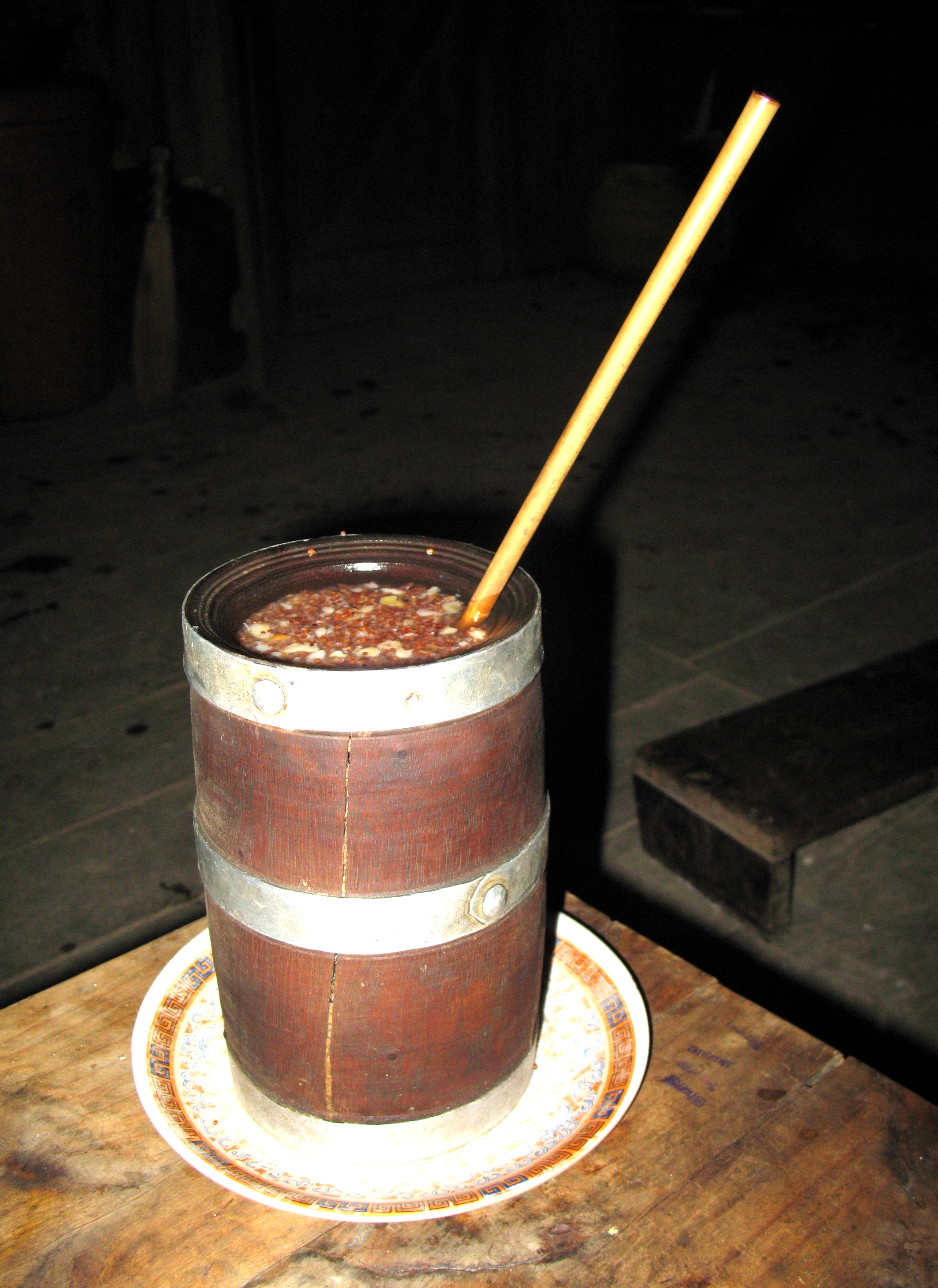|
Somebody has to walk point, yeah. Maybe some of the dumb cousins got weeded out of the genetic family line, and so here we are with our big brains. Somebody write up a grant request! Oops, new page: http://archaeologyinbulgaria.com/20...atiaria-archar/ Otteration fucked around with this message at 05:50 on May 6, 2021 |
|
|
|

|
| # ? May 27, 2024 08:52 |
|
There is a systematic way of testing unknown/new food items to see if they are harmful and its not a leap to suggest that people in the past had similar strategies. Really a lot of is basically "eat or touch a small amount and wait"
|
|
|
|
Telsa Cola posted:There is a systematic way of testing unknown/new food items to see if they are harmful and its not a leap to suggest that people in the past had similar strategies. neolithic peoples had a mikey
|
|
|
|
Otteration posted:There was probably beer at Gobekli Tepi (and other locations) before farming. Yeah but that doesn't necessarily mean they started focusing more on grains because they wanted alcohol, only that fermentation might be one way to make them edible. Getting a buzz from it was also probably pretty sweet but not enough to motivate a huge change of life that meant a lot of extra work I think. At the time Göbekli Tepe was built I'm sure they were collecting wild grasses that grew in abundance around them and slowly becoming more reliant on them. Apropos of drugs, the opium poppy was cultivated very early on. It's hard to tell if it was for the seeds, as anaesthetic, for recreational use or a bit of all three though.
|
|
|
|
Otteration posted:There was probably beer at Gobekli Tepi (and other locations) before farming. Fuschia tude posted:The Japanese were using, and possibly growing, it at least as early as 10,000 years ago, and they probably got it from Asia: https://www.google.com/books/edition/Cannabis/SnUlDQAAQBAJ?hl=en&gbpv=1&pg=PA96&printsec=frontcover interesting stuff
|
|
|
|
Jamwad Hilder posted:neat thread. It's long so I'm not going to link them all. it's an interesting thread, but twitter makes everything worse by forcing the writers to adopt an awful style to make the text fit
|
|
|
|
Telsa Cola posted:There is a systematic way of testing unknown/new food items to see if they are harmful and its not a leap to suggest that people in the past had similar strategies. Then decide whether or not you enjoyed being poisoned.
|
|
|
|
Watch if animals eat it first would be most of the work I’d assume. After that yeah little nibbles. Truly amazing is someone found the first non-bitter almond mutant.
|
|
|
|
Jamwad Hilder posted:neat thread. It's long so I'm not going to link them all. Summary: imperial Rome puts the dirt in fighting dirty.
|
|
|
|
It takes some bad luck to find something really poisonous though. Most stuff is just hard to digest, lots of stuff in nature has evolved to be eaten and signals this by tasting nice. Then there's the whole "don't eat this or else the gods will punish you" cultural thing which lets a bad lesson learned stick around for a long time. It's still prevalent today, outside of religious dietary restrictions, at least in 1 case I know of. I think it was a parenting shortcut. My mom didn't think the scientific facts about car exhaust in enclosed spaces was easy enough to explain to my younger brother, so she invented the "tunnel witch".
|
|
|
|
To further support that agriculture was in part because of alcohol, modern edible maize was created after first using the wild almost wheat like plant to make cornbeer.
|
|
|
|
The other thing is that humans (primates, really) diverged from other mammals to be substantially more alcohol friendly about 10MYA. I know chimpanzees will deliberately seek out some alcohol (e.g. palm wine) but I don't know if we have evidence of them deliberately producing it. But making fruit-based alcohols could massively predate grain-based ones for all I know. Anecdotally, if you make a sourdough starter it will pretty regularly produce hooch, so bread and beer are probably not really separable developments. On the other side, even if alcohol wasn't the lead in to farming, I do think it was very important for city-building. It's a little tough to think about timelines because by the time we get literary evidence, cities were already established and complex with whole systems of government and religion and everything. But in that literary evidence it seems pretty clear to me that alcohol production was a valued source of legitimacy for the whole way of life, and was tied into the economy and religion in multiple ways.
|
|
|
|
Tulip posted:I don't know if we have evidence of them deliberately producing it. This is just one data point but... 
|
|
|
|
Telsa Cola posted:There is a systematic way of testing unknown/new food items to see if they are harmful and its not a leap to suggest that people in the past had similar strategies. Universal edibility test.
|
|
|
|
Hunter Gatherer birth rates were low enough so if you were depending on your cousins karking it to test if foods are edible or not, you're going to very quickly run out of cousins. Broadly speaking, a community that has adapted to a certain geographical location is going to be familiar with the potential food sources that grow in the location, primarily through cultural knowledge. Move to a new and unfamiliar area, then you're going to have to work out what can be eaten. Well hunter gathering humans don't move that far at once, you seek similar environs, and that means you have time to probe new food sources even as you prioritize familiar ones. Conveniently, prey animals tend to lack poisons, and while hunting solitary animals isn't the same as hunting herd animals, you use fundamentally similar tools. And if you're a neolithic farmer, you can bring your entire package of food production species along with you. Just hope that they grow in the new location.
|
|
|
|
Grevling posted:Yeah but that doesn't necessarily mean they started focusing more on grains because they wanted alcohol, only that fermentation might be one way to make them edible. Getting a buzz from it was also probably pretty sweet but not enough to motivate a huge change of life that meant a lot of extra work I think. At the time Göbekli Tepe was built I'm sure they were collecting wild grasses that grew in abundance around them and slowly becoming more reliant on them. Yep, we don't know for sure yet. There is gobs of evidence at Gobleki Tepi that shows it was a site for feasting. Gobs of food (meat), some uneaten and wasted. None of it was grain, or bread. Except for the beer. Then maybe later some mixture of someone ground some grain up for food later on, then they cooked it, then someone started to make bread, and somewhere in that they figured out how to grow and hybridize it. E: Yep, needs a source.  "In about 22 years of ongoing fieldwork, the German Archaeological Institute and the Şanlıurfa Museum have revealed a totally unexpected monumental architecture at Göbekli Tepe, dating to the earliest Neolithic period. No typical domestic structures have yet been found, leading to the interpretation of Göbekli Tepe as a ritual centre for gathering and feasting. The people creating these megalithic monuments were still highly mobile hunter-foragers and the site’s material culture corroborates this: substantial amounts of bones exclusively from hunted wild animals, and a stone tool inventory comprising a wide range of projectile points. Osteological investigations and botanical studies show that animal husbandry was not practiced at Göbekli Tepe and domesticated plants were unknown." https://www.asor.org/anetoday/2017/07/gobekli-tepe/ Otteration fucked around with this message at 17:53 on May 6, 2021 |
|
|
|
Mr. Nice! posted:To further support that agriculture was in part because of alcohol, modern edible maize was created after first using the wild almost wheat like plant to make cornbeer. That's a 100% not a definite thing and having worked both in Maya land and in the US southwest this is literally the first I am hearing about it. Edit: oh there was some papers in like 2009 that discusses the sugary stock maaaybe being utilized for alcohol production but that glosses over the fact we already see and have better evidence of the utilization of it as a food source. One of the dudes pushing the idea came around when some other data popped up. Im not really a fan of the whole alcohol to cities/sedentary idea because to be frank we don't really see the amount of material support for the idea that would be expected and needed if it played such an important role. Telsa Cola fucked around with this message at 18:14 on May 6, 2021 |
|
|
|
Crab Dad posted:Watch if animals eat it first would be most of the work I’d assume. After that yeah little nibbles. Truly amazing is someone found the first non-bitter almond mutant. "Look, the birds are eating those little pointy red fruit without problems. I'm sure it'll be fine for us..."
|
|
|
|
Wasn't early beer more like a fermented porridge, anyway? It may have been the easiest way to turn early grains into calories, with the alcohol being a side benefit.
|
|
|
|
In Nepal/Tibet, alot of villages still make simple alcoholic beverages that require very little preparation. Two that come to mind are: Chhaang- beer of sorts made from cooked rice/barley/millet left to ferment with some yeast and filtered and served cold. Gets pretty strong depending on time and prep but has an alcohol content of around 5%  Tongba- Boiled millet left to ferment and stored for a longer period than Chhaang. Served in a special container where hot water is poured over it and the resulting concoction is drank through a straw to filter out the millet solids. Mild alcohol content of 2~3% due to dilution with water. Its also interesting because anthropologists have used the cultivation of certain grains (the dominance of rice/barley/millet) as a sort of indicator of origin/spread of certain ethnic groups within the Himalayan region. Talking about alcohols made me home sick and made me think of the origin story of Kathmandu valley. The story goes that the valley was a huge lake until one day the goddess Manjusri flew by and saw a patch of lotus growing. They proceeded to cut a gorge draining the lake and the spot where the lotus was growing was turned into Swayambhunath stupa by the people that settled in the valley. Kathmandu valley was indeed a lake until ~12000 years ago (with two major drainage events occurring around 48000 and 38000 years ago), being a bowl shaped valley shaped by glaciers and tectonics. They coincide perfectly with the Pleistocene (period of glaciation) and the Holocene (period of warming and glacier retreat). Evidence of human movement and settlement in the Himalayan region also coincides with the drainage of the valley with evidence of human presence in the Tibetan plateau reaching back 13000 years. Additionally the singular event (Manjusri cutting a gorge) leading to the drainage of the lake also fits the geological evidence, since Kathmandu valley sits on a geological fault where massive earthquakes are common. Meaning that the valley was drained due to sudden catastrophic events such as earthquakes as opposed to a slower drain through evaporation (eg, Mexico valley). Sadly the archeological study of the valley is less robust (easier to study rock strata and ground core samples than human activity that vanishes easily) so i cant speak to that. The iconography and history of the large sedentary cultures in the valley does show that Yadavs and Licchavis displaced people in the valley. Statues and stories of captured wild men a visible through out the valley, and there still exists several small, persecuted ethnic group such as the Raute and Raji peoples that still live nomadic hunter gatherer lifestyles. So we can assume people lived in the valley long before the Yadavs and Licchavis.  common imagery of 'wild men' found in temples across the valley link to geological study My question is, what other mythical story has elements of truth that are proven by evidence? ughhhh fucked around with this message at 22:50 on May 6, 2021 |
|
|
|
Elissimpark posted:"Look, the birds are eating those little pointy red fruit without problems. I'm sure it'll be fine for us..." Dont the birds get hosed up on it and fly into poo poo if they eat many?
|
|
|
|
Hamsters make alcohol by stashing fruit in their burrows, and consuming it a few months later after it's fermented. Their liver is five times bigger, relative to body size, than a normal mammal's liver.
|
|
|
Chamale posted:Hamsters make alcohol by stashing fruit in their burrows, and consuming it a few months later after it's fermented. Their liver is five times bigger, relative to body size, than a normal mammal's liver.
|
|
|
|
|
ughhhh posted:
Off the top of my head you have a bunch of flooding myths that may have to deal with people having to leave the coastlines when sea levels rose. You have First Nation/Inuit stories about what happened to that group of English explorers that was pretty accurate. Australian Aborigines had stories about hawks carrying flames and such that was first really scientifically recorded in the last twoish years. Probably a whole lot more.
|
|
|
|
FishFood posted:Wasn't early beer more like a fermented porridge, anyway? It may have been the easiest way to turn early grains into calories, with the alcohol being a side benefit. Edit: Oh I see what you are saying. Yeah it could have been that or just ground grains or other items added to a liquid as a drink. You make a big batch or whatever and don't get through it all/forget about it and welp now it ferments. Telsa Cola fucked around with this message at 01:13 on May 7, 2021 |
|
|
|
ughhhh posted:My question is, what other mythical story has elements of truth that are proven by evidence? I think a lot of myths about how mountains and stuff were formed are pretty firmly based on actual geological events. Like the Native American legends about Crater Lake & Bridge of the Gods, for example. Also I remember reading about how the coastal tribes had legends about great waves smashing up the coast ~400 years ago that were fairly recently discovered to be true.
|
|
|
|
Telsa Cola posted:Edit: Oh I see what you are saying. Yeah it could have been that or just ground grains or other items added to a liquid as a drink. You make a big batch or whatever and don't get through it all/forget about it and welp now it ferments. https://www.youtube.com/watch?v=EoihKUbmM38
|
|
|
|
I think the locals on the island of Flores, where the 1-meter tall hominid Homo floresiensis lived, have stories of mythological diminutive humanoids. Not exactly proof of anything, but it would be a hell of a cultural memory, considering floresiensis seems to have gone extinct ~50k years ago e: reading more into it, this theory got traction when the floresiensis remains were mistakenly dated to 12k years ago, which is a much more plausible period than 50k.
|
|
|
|
cheetah7071 posted:I think the locals on the island of Flores, where the 1-meter tall hominid Homo floresiensis lived, have stories of mythological diminutive humanoids. Not exactly proof of anything, but it would be a hell of a cultural memory, considering floresiensis seems to have gone extinct ~50k years ago Lotta folks have a story of little peoples. Its not unique to the Flores.
|
|
|
|
Telsa Cola posted:Lotta folks have a story of little peoples. Its not unique to the Flores. Yeah it could be a coincidence. It could also have its origin in them finding bones. I've heard speculation that Chinese dragon legends have their origin in dinosaur bones, which are really easy to find in some areas.
|
|
|
|
https://m.youtube.com/watch?v=3ioX8RWTvTs
|
|
|
|
There are theories that the Fimbulwinter, a winter lasting years and heralding Ragnarök, are memories of climate disruption caused by a volcano eruption in the 500s.
|
|
|
|
sullat posted:I think a lot of myths about how mountains and stuff were formed are pretty firmly based on actual geological events. Like the Native American legends about Crater Lake & Bridge of the Gods, for example. Also I remember reading about how the coastal tribes had legends about great waves smashing up the coast ~400 years ago that were fairly recently discovered to be true. Almost. It was a pac nw earthquake that sunk a bunch of land And saltwater killed the trees. The locals had stories about this and it was dated approximately. The Japanese on the other side of the Pacific kept meticulous records of earthquakes and tidal waves and on a very specific day in the 1700s had a tidal wave with no earthquake. Other cool stories are the aboriginal stories about land that has been underwater for 10000 years and similar situations where geological studies have verified the age of verbally passed down stories.
|
|
|
|
Crab Dad posted:Dont the birds get hosed up on it and fly into poo poo if they eat many? I don't think so, that would probably defeat the purpose of using birds to spread your seeds. If you've seen something confirming it, I'd like to read it, though.
|
|
|
|
https://www.mercurynews.com/2018/11/27/are-birds-and-critters-getting-drunk-on-fermented-berries/ https://ruthkassinger.com/ravenous-robins-ravage-holly/ Interesting claim on this one that holly berries get less toxic as the season goes on. I dunno.
|
|
|
|
Plants engorge their fruits with sugars because it's a good way of attracting seed dispersing species that allows the plants to propagate. The fact that these sugars also attract yeasts that intoxicate their fruits with alcohol is irrelevant, because seeds can still get dispersed even if a few dispersers get intoxicated and die. Well, it's birds that tend to fare badly, mammals tend to do fine even when their fruits are intoxicated.
|
|
|
|
I just realized my post took the same form as a question during the q&a of a conference.
|
|
|
|
I wanna know more about hawks carrying fire
|
|
|
|
a fatguy baldspot posted:I wanna know more about hawks carrying fire During a fire animals have to flee the burning area. Since they are unable to move cautiously they are vulnerable to predation, mostly by birds that don't have to fear the fire themselves. A number of species will fly toward fires to take advantage of this. One specifically however will pick up smouldering sticks, fly them to an adjacent area and drop them to spread the fire further and flush out more prey.
|
|
|
|

|
| # ? May 27, 2024 08:52 |
|
Ola posted:I've heard speculation that Chinese dragon legends have their origin in dinosaur bones, which are really easy to find in some areas. This is one of those theories that, though probably impossible to definitively prove, is so convincing I feel like it has to be right. Like, imagine you are a practical, non-gullible stone age person who stumbles upon a plesiosaur skeleton on the top of a mountain.  "Yeah right buddy, I know a dragon when I see one." "Yeah right buddy, I know a dragon when I see one."
|
|
|








































